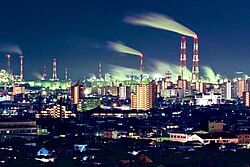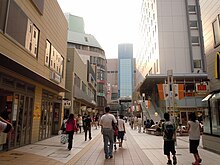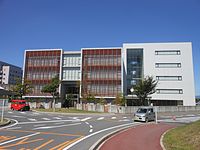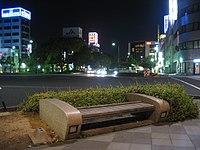| Yokkaichi 四日市市 | |||||||||
|---|---|---|---|---|---|---|---|---|---|
| Special city | |||||||||
     
| |||||||||
 Flag Flag Seal Seal | |||||||||
 Location of Yokkaichi in Mie Prefecture Location of Yokkaichi in Mie Prefecture | |||||||||
 | |||||||||
| Coordinates: 34°57′54.1″N 136°37′27.9″E / 34.965028°N 136.624417°E / 34.965028; 136.624417 | |||||||||
| Country | Japan | ||||||||
| Region | Kansai | ||||||||
| Prefecture | Mie | ||||||||
| Government | |||||||||
| • Mayor | Tomohiro Mori | ||||||||
| Area | |||||||||
| • Total | 206.44 km (79.71 sq mi) | ||||||||
| Population | |||||||||
| • Total | 310,259 | ||||||||
| • Density | 1,500/km (3,900/sq mi) | ||||||||
| Time zone | UTC+9 (Japan Standard Time) | ||||||||
| Phone number | 059-354-8244 | ||||||||
| Address | 1-5 Suwa-chō, Yokkaichi-shi, Mie-ken 510-8601 | ||||||||
| Climate | Cfa | ||||||||
| Website | Official website | ||||||||
| Symbols | |||||||||
| Bird | Black-headed gull | ||||||||
| Flower | Salvia splendens | ||||||||
| Tree | Cinnamomum camphora | ||||||||
Yokkaichi (四日市市, Yokkaichi-shi) is a city located in Mie Prefecture, Japan. As of 1 August 2021, the city had an estimated population of 310,259 in 142162 households and a population density of 1500 persons per km. The total area of the city is 206.44 square kilometres (79.71 sq mi).
Geography
Yokkaichi is located in the north-central of Mie Prefecture, part of the northeastern Kii Peninsula. It stretches the width of Mie Prefecture, and is bordered by Ise Bay on the Pacific Ocean to the east, and Shiga Prefecture to the northwest.
Neighboring municipalities
Mie Prefecture
Climate
Yokkaichi has a Humid subtropical climate (Köppen Cfa) characterized by warm summers and cool winters with light to no snowfall. The average annual temperature in Yokkaichi is 15.2 °C (59.4 °F). The average annual rainfall is 1,807.3 mm (71.15 in) with September as the wettest month. The temperatures are highest on average in August, at around 26.8 °C (80.2 °F), and lowest in January, at around 4.3 °C (39.7 °F).
| Climate data for Yokkaichi (1991−2020 normals, extremes 1966−present) | |||||||||||||
|---|---|---|---|---|---|---|---|---|---|---|---|---|---|
| Month | Jan | Feb | Mar | Apr | May | Jun | Jul | Aug | Sep | Oct | Nov | Dec | Year |
| Record high °C (°F) | 19.9 (67.8) |
22.2 (72.0) |
24.5 (76.1) |
29.5 (85.1) |
33.1 (91.6) |
35.4 (95.7) |
37.9 (100.2) |
38.8 (101.8) |
36.9 (98.4) |
31.5 (88.7) |
24.8 (76.6) |
21.9 (71.4) |
38.8 (101.8) |
| Mean daily maximum °C (°F) | 9.0 (48.2) |
10.0 (50.0) |
13.3 (55.9) |
18.7 (65.7) |
23.2 (73.8) |
26.1 (79.0) |
29.9 (85.8) |
31.4 (88.5) |
27.7 (81.9) |
22.4 (72.3) |
17.0 (62.6) |
11.5 (52.7) |
20.0 (68.0) |
| Daily mean °C (°F) | 4.3 (39.7) |
4.9 (40.8) |
8.1 (46.6) |
13.3 (55.9) |
18.0 (64.4) |
21.7 (71.1) |
25.6 (78.1) |
26.8 (80.2) |
23.2 (73.8) |
17.5 (63.5) |
11.8 (53.2) |
6.6 (43.9) |
15.2 (59.3) |
| Mean daily minimum °C (°F) | −0.1 (31.8) |
0.0 (32.0) |
2.9 (37.2) |
7.9 (46.2) |
13.0 (55.4) |
17.8 (64.0) |
22.2 (72.0) |
23.2 (73.8) |
19.4 (66.9) |
13.0 (55.4) |
7.1 (44.8) |
2.0 (35.6) |
10.7 (51.3) |
| Record low °C (°F) | −6.0 (21.2) |
−6.3 (20.7) |
−4.6 (23.7) |
−1.1 (30.0) |
3.8 (38.8) |
9.8 (49.6) |
13.7 (56.7) |
15.8 (60.4) |
9.7 (49.5) |
2.2 (36.0) |
−1.0 (30.2) |
−5.6 (21.9) |
−6.3 (20.7) |
| Average precipitation mm (inches) | 55.5 (2.19) |
67.2 (2.65) |
117.8 (4.64) |
153.7 (6.05) |
189.3 (7.45) |
249.0 (9.80) |
208.0 (8.19) |
158.8 (6.25) |
286.9 (11.30) |
182.9 (7.20) |
79.7 (3.14) |
58.5 (2.30) |
1,807.3 (71.15) |
| Average rainy days (≥ 1.0 mm) | 5.9 | 7.2 | 9.2 | 9.2 | 9.9 | 12.3 | 11.7 | 8.9 | 11.5 | 9.4 | 6.1 | 6.4 | 107.7 |
| Average snowy days | 10.0 | 8.9 | 4.3 | 0.4 | 0 | 0 | 0 | 0 | 0 | 0 | 0.1 | 5.3 | 29 |
| Average relative humidity (%) | 68 | 67 | 65 | 67 | 73 | 79 | 83 | 79 | 80 | 75 | 74 | 71 | 73 |
| Mean monthly sunshine hours | 152.2 | 149.5 | 181.7 | 189.8 | 194.2 | 147.9 | 162.4 | 196.2 | 151.8 | 153.9 | 156.8 | 151.6 | 1,988 |
| Source: Japan Meteorological Agency | |||||||||||||
Demographics
Per Japanese census data, the population of Yokkaichi has increased steadily over the past 60 years.
| Year | Pop. | ±% |
|---|---|---|
| 1960 | 206,379 | — |
| 1970 | 241,409 | +17.0% |
| 1980 | 266,756 | +10.5% |
| 1990 | 285,015 | +6.8% |
| 2000 | 302,102 | +6.0% |
| 2010 | 307,807 | +1.9% |
History

The area around modern Yokkaichi has been settled since prehistoric times. Numerous Kofun period burial mounds have been discovered, and the area was one of the battle sites of the Asuka period Jinshin War. However, until the end of the Heian period, the area was sparsely settled, and the site of Yokkaichi was only a small port village. The area developed during the Kamakura period and by the Azuchi–Momoyama period, the port was developed and a regular market was opened on the 4th, 14th, and 24th day each month. Thus, the city is named Yokkaichi: "yokka" means fourth day, and "ichi" means market. After the Honnō-ji Incident during which warlord Oda Nobunaga was assassinated, Tokugawa Ieyasu fled from Yokkaichi port by sea to his castle at Edo. Under the Tokugawa shogunate, Yokkaichi was tenryō territory controlled directly by the shōgun and administered by a daikan based at the Yokkaichi Jin'ya. Throughout the Edo period, the area prospered as Yokkaichi-juku, the forty-third station on the Tōkaidō highway connecting Edo with Kyoto. However, the city was largely destroyed by the Ansei great earthquakes.
Following the Meiji Restoration, Yokkaichi Town was established with the creation of the modern municipalities system on April 1, 1889, and was designated the capital of Mie Prefecture. Yokkaichi's port advanced remarkably during the Meiji period, primarily under the guidance of Inaba Sanuemon, a resident merchant interested in increasing trade in the Yokkaichi and Ise area by modernizing the port facilities. Starting in 1872, the project took 12 years to complete due to typhoons and difficulties in financing the project. This led to the port city being designated an Official International Port in 1899 The primary trade items shipped through Yokkaichi were originally seed oil, Banko ware, and Ise tea; but now it has developed into a port that handles cotton, wool, glass, and heavy equipment. Yokkaichi was elevated to city status on August 1, 1897.
From 1939, Yokkaichi became a center for the chemical industry, with the Imperial Japanese Navy constructing a large refinery near the port area. Yokkaichi was one of the first cities bombed by the United States during World War II, when on April 18, 1942, the city was attacked by aircraft from the Doolittle Raid. During the final stages of World War II, on June 18, 1945, 89 B-29 Superfortress bombers dropped 11,000 incendiary bombs destroying 35% of the urban area and killing 736 people. This attack on Yokkaichi was followed by another eight air raids until August 8, 1945, killing another 808 people.
From 1960 to 1972, the city residents suffered health problems caused by the emission of SOx into the atmosphere from local petrochemical and chemical plants. In Japan, a disease called Yokkaichi zensoku (Yokkaichi asthma) derives its name from the city, and it is considered one of the Four Big Pollution Diseases of Japan.

Yokkaichi attained special city status on November 1, 2000, with increased local autonomy.
On February 7, 2005, the town of Kusu (from Mie District) was merged into Yokkaichi.
Government
Yokkaichi has a mayor-council form of government with a directly elected mayor and a unicameral city council of 34 members. Yokkaichi contributes seven members to the Mie Prefectural Assembly. In terms of national politics, the city is divided between Mie 2nd district and Mie 3rd district of the lower house of the Diet of Japan.
Economy
Yokkaichi is a manufacturing center that produces Banko ware (a kind of earthenware and stoneware), automobiles, cotton textiles, chemicals, tea, cement, and computer parts such as flash memory by Kioxia and Western Digital.
Education

- Universities
- Primary and secondary education
Yokkaichi has 38 public elementary schools and 22 public middle schools operated by the city government, and there are three private middle schools. The city also operates one special education school for the disabled. The city has ten public high schools operated by the Mie Prefectural Board of Education and five private high schools. The prefecture also operates two special education schools for the disabled.
- International schools
- Escola Nikken (ニッケン学園) — Brazilian school
- Yokkaichi Korean Elementary and Middle School (四日市朝鮮初中級学校) — North Korean school
Transportation



Railway
![]() Kintetsu Railway – Nagoya Line
Kintetsu Railway – Nagoya Line
- Kintetsu Tomida - Kasumigaura - Akuragawa - Kawaramachi - Kintetsu Yokkaichi - Shinshō - Miyamado - Shiohama - Kita-Kusu - Kusu
![]() Kintetsu Railway – Yunoyama Line
Kintetsu Railway – Yunoyama Line
Yokkaichi Asunarou Railway – Utsube Line
Yokkaichi Asunarou Railway – Hachiōji Line
![]() Sangi Railway – Sangi Line
Sangi Railway – Sangi Line
Highway
 Isewangan Expressway
Isewangan Expressway Shin-Meishin Expressway
Shin-Meishin Expressway Higashi-Meihan Expressway
Higashi-Meihan Expressway National Route 1
National Route 1 National Route 23
National Route 23 National Route 25
National Route 25 National Route 164
National Route 164 National Route 306
National Route 306 National Route 365
National Route 365 National Route 477
National Route 477
Seaports
- Yokkaichi Port
Local attractions
Festivals and events
- Amagasuka Ishidori Festival
- Great Yokkaichi Festival
- Matsubara Ishidori Festival
International relations
Yokkaichi has two sister cities and one sister port.
 Long Beach, California, United States, since October 7, 1963
Long Beach, California, United States, since October 7, 1963 Sydney Port, Australia, since October 24, 1968
Sydney Port, Australia, since October 24, 1968 Tianjin, China, since October 28, 1980
Tianjin, China, since October 28, 1980
Notable people from Yokkaichi
- Toshiya Fujita, movie director
- Naoki Hattori, racing driver
- Goseki Kojima, manga artist
- Masayo Kurata, voice actress
- Miki Mizuno, actress
- Fumio Niwa, author
- Katsuya Okada, politician
- Takuya Okada, chairman emeritus of AEON Group
- Satoshi Saida, wheelchair tennis player
- Naoki Segi, movie director
- Shuu Shibutani, professional wrestler
- Ui Shigure, light novel artist and virtual YouTuber
- Yoriko Shono, writer
- Ōzutsu Takeshi, sumo wrestler
- Katsuaki Watanabe, president of Toyota Motor Corporation
References
- "Yokkaichi city official statistics" (in Japanese). Japan.
- ^ 気象庁 / 平年値(年・月ごとの値). JMA. Retrieved February 17, 2022.
- 観測史上1~10位の値(年間を通じての値). JMA. Retrieved February 17, 2022.
- Yokkaichi population statistics
- US Department of State. (1906). A digest of international law as embodied in diplomatic discussions, treaties and other international agreements (John Bassett Moore, ed.), Vol. 5, p. 759.
- "Japanese Banko ware Identification & Marks". Blue Cherry Antiques. Retrieved 19 October 2021.
- "Escolas Brasileiras Homologadas no Japão" (Archived 2015-10-18 at the Wayback Machine). Embassy of Brazil in Tokyo. Retrieved on October 13, 2015.
- ウリハッキョ一覧. Chongryon. Archived from the original on 2015-12-19. Retrieved October 14, 2015.
- "International Exchange". List of Affiliation Partners within Prefectures. Council of Local Authorities for International Relations (CLAIR). Archived from the original on 5 February 2016. Retrieved 21 November 2015.
External links
- Yokkaichi City official website (in Japanese)
- Yokkaichi Information, Movie, and Community Portal Archived 2012-04-14 at the Wayback Machine TranslatablePage
- Hiroshige prints of the Tokaido - Station 44 Yokkaichi Archived 2012-06-11 at the Wayback Machine
 Geographic data related to Yokkaichi at OpenStreetMap
Geographic data related to Yokkaichi at OpenStreetMap
| Tsu (capital) | ||
| Special city | ||
| Cities | ||
| Districts | ||
| List of mergers in Mie Prefecture | ||
| Metropolitan cities of Japan | |
|---|---|
| also a prefectural capital; eligible for core city status but not yet nominated; to become core cities |